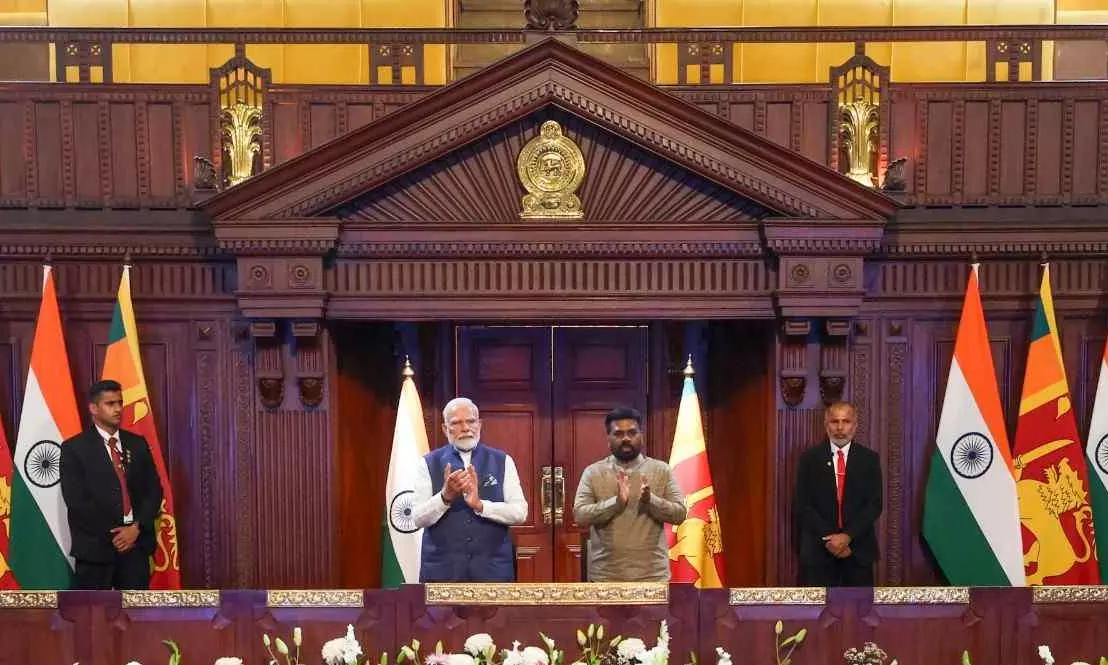
4 decades after Lanka misadventure, India bolsters ties with defence deal
Amid China’s growing influence in region, Dissanayake reiterates that Colombo won’t let its territory be used in any way inimical to New Delhi’s security interests

India and Sri Lanka have signed a wide-ranging defence agreement for the first time, with Prime Minister Narendra Modi saying on Saturday (April 5) that the security interests of the two countries were “interlinked and dependent on each other”.
Modi, on a three-day state visit that ends on Sunday, made the remarks shortly after New Delhi and Colombo signed a slew of MoUs covering fields as diverse as defence, power grid, digital economy, energy, grant for eastern province, and health and pharma.
Award for Modi
President Anura Dissanayake, who conferred Sri Lanka’s highest award for a foreign leader on Modi, pledged that Colombo won’t let its territory be used in any manner inimical to New Delhi’s security interests.
The two leaders also virtually inaugurated a 50 MW solar energy plant at Sampur in the eastern district of Trincomalee, a temperature-controlled agricultural warehouse at Dambulla, and solar rooftop systems for 5,000 religious centres across Sri Lanka.
Also read: India, Sri Lanka ink defence pact following talks between PM Modi, Dissanayake
One of the MoUs covered a trilateral pact involving India, Sri Lanka, and the United Arab Emirates to develop Trincomalee on the east coast as an energy hub.
Modi on India-Lanka ties
After the MoUs were signed in Colombo, Modi, who flew into Sri Lanka on Friday night from Bangkok, said: "We believe our security interests are similar. The security of both countries is interlinked and dependent on each other. I am grateful to President Dissanayake for his sensitivity towards India’s interests. We welcome the important agreements concluded in defence cooperation.”
Dissanayake, a Marxist who stormed to power last year, told Modi that he deeply cherished India’s decision to come to Sri Lanka’s rescue after an unprecedented economic crisis derailed the country in 2022, causing political tremors, and for continuing with the solidarity.
The defence agreement
The defence pact, a major move to bolster strategic ties amid China’s steadily growing influence in the Indian Ocean Region, came nearly four decades after India’s costly military intervention in the Sri Lankan ethnic conflict in 1987-90.
Indian troops ended up fighting the now-vanquished Tamil Tiger guerrillas. By the time the Indian military withdrew home, they lost some 1,200 soldiers while hundreds were wounded and maimed.
The Sri Lankan government went out of its way earlier on Saturday to dismiss fears being raised by sections of the political establishment over the defence pact, underlining that it was for mutual good.
Also read: Katchatheevu: Can Modi’s Lanka visit help India reclaim fishing rights?
A five-year pact
Defence Secretary Sampath Thuyacontha said the MoU on defence cooperation was aimed at “continuing the defence partnership and engagements more efficiently and in a structured manner”.
The pact will be in force for five years. Either country could terminate it with a three-month notice. The accord could also be extended every three years.
According to the official, the proposed agreement will cover the exchange of military officers, training, staff talks between the forces, exchange of information, cooperation in defence industry, and in defence technology and research. All this will be “carried out in a professional manner”.
Sampur power project
Modi said in his statement that the Sampur solar power plant would help in Sri Lanka’s energy security.
“All the people of Sri Lanka will (also) benefit from the agreements signed for building a multi-product pipeline and developing Trincomalee as an energy hub,” he added.
The grid inter-connectivity agreement between the two countries will open up options for Sri Lanka to export electricity, he said.
Also read: Modi, Stalin, Dissanayake should resolve fishermen issue: Lanka MP Ganesan
Other announcements
Modi said Sri Lanka has a "special place” in India’s Neighbourhood First policy and Vision ’MAHASAGAR’.
"In the last four months, since President Dissanayake’s visit to India, our cooperation has progressed significantly,” he added.
The Indian leader also announced a comprehensive capacity-building programme for 700 Sri Lankans annually, as well as Indian grant to develop the historic Thirukoneswaram temple dedicated to Lord Shiva in Trincomalee and the Sita Eliya temple in Nuwara Eliya, a tea-growing region in the central hills of the island nation.
Modi in Anuradhapura
Earlier, Dissanayake presented Modi with the Sri Lanka Mitra Vibhushana award, the country’s highest honour for any foreign leader.
Modi, who is visiting Sri Lanka for a fourth time as prime minister, will on Sunday fly to Anuradhapura, a sacred Buddhist town some 200 km north of Colombo along with President Dissanayake.
Before Modi and Dissanayake held restricted talks and then joined the their delegations, Modi was accorded a ceremonial welcome at the Independence Square in the heart of the Sri Lankan capital, in the first such honour given to a foreign leader.
Also read: PM Modi’s Sri Lanka visit: Can it reset ties and contain China?
Indian war ship
Coinciding with Modi’s visit, the Indian Naval Ship (INS) Sahyadri arrived at Colombo port on Friday.
INS Sahyadri is a 143-m long frigate manned by a crew of 320 and it is commanded by Captain Rajat Kumar. It will sail out of Colombo on April 7.
India and Sri Lanka are separated by a narrow strip of sea.
